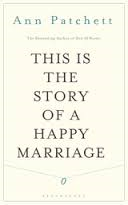This Is the Story of a Happy Marriage
- By Ann Patchett
- HarperCollins
- 320 pp.
- Reviewed by Patricia Schultheis
- December 3, 2013
The award-winning writer presents 22 essays that reveal her deepening understanding of love and commitment.

This Is the Story of a Happy Marriage, the latest book from Ann Patchett, is a treat to read and a form unto itself. A collection of essays, it flirts with memoir without memoir’s narrow focus, while delving into topics as varied as opera, nuns, recreational vehicles and floods. Throughout this collection, Patchett revisits themes, settings and people. Characters met casually in one essay, such as Patchett’s grandmother, friends and husband, have greater significance in a second and are as familiar as old friends by the third. What emerges from this very loose chronological grouping is a sense of Patchett’s deepening understanding of love and commitment.
Patchett writes like Tiger Woods swings a nine iron — they both make their craft look easy, but only because the onlooker never witnessed their long, dedicated apprenticeships. Now widely admired for her literary fiction, for many years Patchett supported her dedication to that genre by writing nonfiction, and the 22 essays in this volume are culled mainly from those pieces, some of which have been expanded or were written with this collection in mind (although these, too, initially appeared elsewhere). In her introduction, Patchett explains how, when Seventeen magazine demanded she revise a 250-word book review several times, she “trimmed and tucked, [and] found a single word to express five words’ worth of feeling.” All that journalistic precision has resulted in writing that moves like a bullet train: it cocoons the reader in comfort while carrying her forward with seemingly effortless energy.
Describing her adopted home state’s flora, Patchett writes, “Tennessee’s plants are so competitive that every day is a slugfest: A deciduous tree blocks the light to a shrub, a tendril reaches from beneath the shrub to pull down the tree, insects bore into bark, birds fill out the branches, worms as blind as Homer chew through the soil, crunching the fallen leaves into a thick layer of duff that coats the forest floor.” Sixty-five words, sixty-three so simple a third grader could sound them out, yet there’s momentum and meaning enough to carry along the most sophisticated reader.
Like any highly skilled artist, Patchett adjusts her medium to most aptly express her vision. “I stayed in the room with her and held her hand when the dentist pulled out her tooth,” she writes of the incremental deterioration of her grandmother. “I turned back her eyelids to clean out a persistent infection. I swabbed out her ears. I learned how to remove impactions.” Bare-bones writing for a bare-bones situation. Anything less austere would detract from her grandmother’s long decline. And diminish its significance.
As might be expected of any collection having aspects of memoir, several essays address the most important element of Patchett’s life: writing. Four essays deal with it almost exclusively. She acknowledges the professors at Sarah Lawrence who influenced her and details her dawning awareness of the commitment the writing life demands, her determination to affix writing at the top of her priorities, the yin and yang of fiction versus nonfiction, the many methods of storytelling and the right to read. Perhaps writers will enjoy these essays more than general readers, but that’s doubtful. They’re as illuminating and eminently readable as the others in this collection.
Inasmuch as This Is the Story of a Happy Marriage presents a picture of a confident woman who’s met life’s challenges and emerged wiser, grateful and more openhearted, it calls to mind Elizabeth Gilbert. Both Patchett and Gilbert were journalists; both had troubled first marriages and weren’t eager to embark on a second; and both write from an essentially female perspective. While writing is a solitary act, selling it is a commercial enterprise; like Gilbert, Patchett makes clear that she’s very thankful for her readers. She is profoundly aware that readers might have spent their time and money otherwise than on her books, a point that underscores this reviewer’s chief complaint: this collection’s title.
“This Is the Story of a Happy Marriage” is the collection’s 19th essay, which means that a reader, one perhaps who’s desperate for any glimmer of hope for marital happiness, has to read through 18 essays and 237 pages to find the light at the end of the tunnel. Don’t be mistaken: those preceding essays are delightful and the events they relate all contributed to Patchett’s decision to marry a second time, but synechdoche is a clever literary device best applied to text. It should not be employed to lasso readers who might have bought the book anyway, simply because it was written by Ann Patchett.
That said, readers will find much to like in these essays. In their accessible, intimate tone they’re like another character that appears throughout this collection, Patchett’s beloved dog. Like Rose, each essay is nonjudgmental, warm and lets the love shine through.
For her essay on ice skating, Patricia Schultheis most recently won first prize for nonfiction sports writing from Winning Writers. She has been a finalist for the Flannery O’Connor and Snake Nation Press award, and is the author of two dozen published short stories and several essays as well as a book on Baltimore’s Lexington Market. This is her fourth review for Washington Independent Review of Books.

